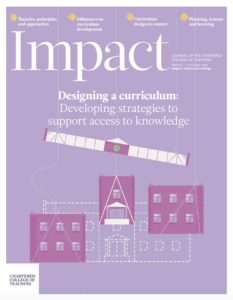Teacher participation in curriculum change: Our school story

Who we are
Sir Christopher Hatton is a mixed state comprehensive school in Wellingborough, Northamptonshire. We are the lead school in a small multi-academy trustAbbreviated to MAT, a group of schools working in collaborat and a base for the Hatton Teaching School Alliance. We are proud of the external recognition our school has received, having been graded ‘outstanding’ in 2015 and during a subsequent inspection, and are now looking at ways in which we can develop further.
How our journey began
As well as engaging students with the content of the statutory National Curriculum, we wanted our school curriculum to support students’ wider development, related to their values and attitudes to each other and themselves. They need to know how to work together, respect each other and value their education: high expectations and self-belief are so important. In reviewing our future development, we asked ourselves, ‘What kind of education do we want for our students?’
How it was undertaken
We wanted our teachers to be involved in curriculum change as we believe that we are more likely to go in the right direction if everyone works together. Teachers want, and are ethically obliged, to do the best for their students. Therefore, they should have the right to participate in curriculum and pedagogical decisions, allowing student needs to be met and promoting continuous improvement in practice (Ho, 2010) (Darling-Hammond et al., 2005). Our journey towards collective decision-making and curriculum change had different stages. Initially, the senior leadership team (SLT) arranged three key meetings with the Heads of Faculty and Teaching and Learning Responsibility (TLR) holders to discuss the curriculum and what our key goals and values should be. These were then shared with the wider staff through a consultation phase, where comments and suggestions were welcomed.
Children and young people are growing up in a globalised world, with instant access to information and opportunities for dialogue and communication with their peers elsewhere in the world through social media (Bourn, 2016). This prompted us to engage with debates about whether our students are ready for the world they are going into, whether they have an understanding of the world away from Wellingborough and how we could realistically prepare them for a future we cannot predict. The first meeting was deliberately unstructured, with our Executive Principal and CEO chairing and making notes of our discussions as we went along. She then came back to the two subsequent meetings with a summary of where we had got to previously, so the ethos and vision behind our curriculum review began to take shape.
Each time, the values and core beliefs took a clearer structure until we had an agreed list of aims and mission statements. These aims – the goals, include:
- to become self-motivated and lifelong learners
- to develop as responsible citizens.
These link to the mission statements – the actions, such as:
- recognise and award achievement
- offer a wide range of enrichment opportunities
- provide a calm, caring ethos that is maintained by encouraging high standards of behaviour, courtesy, and mutual respect’.
Once these principles were agreed upon, it became clear that we needed to consider how we were going to enact them using the potential and talent of our staff.
Impact and changes for next year
The exploration into our curriculum has led to the introduction of new subjects at GCSE and an expansion of SLT and TLR holders we have within the school. In order to make our mission statements a reality, new posts have been created to support our key aims. For example, one post calls for a leader of pupil voice so that our children feel involved and therefore invested in the decisions the school makes. The changes in the GCSEs link to our goals – to ensure that our students have the knowledge to become the well-rounded, respectful people we want them to be. For example, as we want our children to be aware of the world around them, we are introducing a sociology GCSE option. The students have shown their enthusiasm for the subject already, with four classes’ worth opting to take it next year. To ensure that our children don’t feel that there are subjects reserved for the privileged few, out of their reach, we will also start the classical civilisations GCSE in the autumn. A quick Google search put us in touch with Classics for All, an amazing organisation that shares our values of inclusivity (Classics for All, 2018). Most importantly, we realised very quickly that our core values linked heavily to the citizenship curriculum and so a sub-group was formed to explore the possibility at GCSE. We are now in the process of adapting our teaching of PHSE and RE to accommodate the new course. This is our starting point, and new subjects may well be added to our curriculum in the future.
Conclusions
The changes we have made to our curriculum feel positive and a step in the right direction; however, it was the opportunity to meet and discuss something as significant as curriculum change that really excited the team of teachers involved. We found ourselves looking forward to meetings, feeling more motivated and invested in our future plans. Although this curriculum review will have positive implications for our students in the future, the impact on staff involved in the discussions has been instantaneous, leaving us feeling that we practise as we preach with regard to staff and students.










